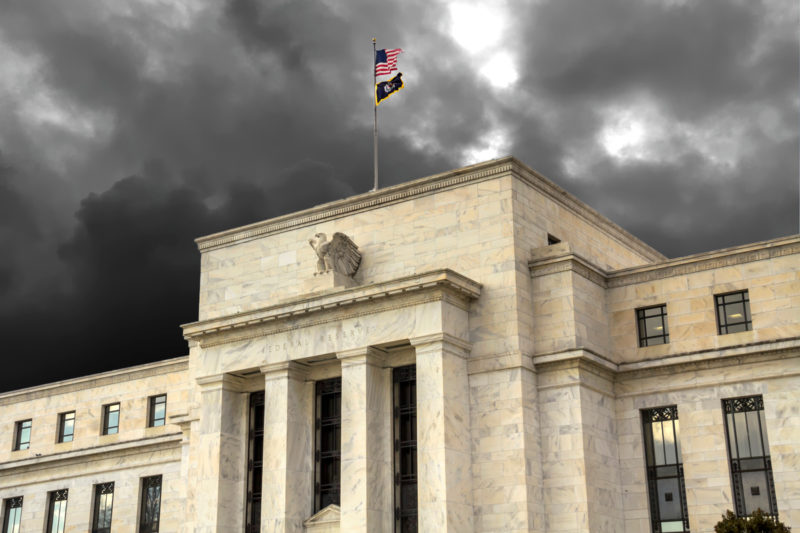The Fed Can’t Revive the Dead, But It Can Delay Their Recovery

A drive through West Virginia is a revelation when it comes to the power of politicians. Thanks to the late Senator Robert Byrd’s extraordinary influence in Washington, many, many billions of private sector U.S. production that Congress arrogated to itself was spent on “Federal” this and that and “Robert Byrd” this and that in West Virginia.
Byrd’s lamentable ability to capture so much U.S. production for his eternally impoverished state was and is an inconvenient truth for the 99.9% of credentialed economists who believe government spending powers economic growth. West Virginia is a reminder of how ridiculous such a belief is.
With government outlays, the growth already occurred; thus the spending. Government spending on the national level amounts to Congress consuming wealth that was already created. Readers might remember this the next time they’re told about soaring GDP growth. Largely a measure of consumption, the latter is a monument to double counting. Consumption is what happens after we’ve produced. GDP is a consequence of economic growth as opposed to a driver of it.
Looked at through the prism of West Virginia, one imagines that GDP in the Mountain State is greater than actual economic growth. Federal programs rarely die, mostly they grow, so it’s a safe bet that money continues to flow into a part of the U.S. that remains at or close to the bottom of the U.S. in terms of economic opportunity.
It’s a reminder that governments can consume the wealth of others with abandon, but they can’t force the wealth consumed to stay. Translated, investment is what drives economic progress. West Virginia is a poor state because investment rarely finds its way there relative to other U.S. states. Basically billions of federal spending occurs annually in the 35th state, only for the money spent to flow out of West Virginia in pursuit of better returns elsewhere.
The inability of Congress to make prosperous what isn’t requires mention ahead of any discussion of the Federal Reserve’s efforts to buy individual corporate bonds. Up front, it should be made clear that the Fed’s buying will prove superfluous. We know this because Fed Chairman Jerome Powell has already made plain that the Fed isn’t in the business of giving grants to ailing businesses. Those loans made by the central bank to corporations ever since the hideous and unnecessary lockdowns began were made based on the assumption that the money would be paid back. In short, the Fed has been making loans that, absent the central bank, would in many instances have already been offered up by profit-motivated lenders.
A Fed that’s well exceeded its initial mandate as “lender of last resort” to solvent banks is now, according to a Wall Street Journal editorial, planning to “underwrite corporate debt to prevent a cascade of bankruptcies.” It will fail.
Just as Congress can’t force capital to remain where it’s not treated well, the Fed can’t force investors to buy that which is hopeless. Furthermore, it’s debatable based on Powell’s aversion to grants that the Fed plans to prop up the hopelessly bankrupt as is. To do so would be for Powell to invite his own central bank’s insolvency. Markets speak loudly and quickly no matter how much the government-enabled spend. See West Virginia.
The Journal editorial added that with Fed “interest rates again near zero, and likely to stay that way for as far as the eye can see, investors are looking to get yield wherever they can.” In this case the editorialists overstate the Fed’s ability to rewrite reality in much the same way that politicians think they can by spending the money of others.
In truth, the Fed cannot decree low rates for businesses, for individuals, or even governments. As a headline in the same newspaper indicated the following day, “Credit Lines to Shale Drillers Dry Up as Lenders Pull Back.” With oil prices low, and worse, uncertain, there’s a reluctance among lenders to provide credit against debt collateralized by oil above or underground. Just as the Fed risks insolvency with imprudent lending, so do actual lenders.
Despite this, it’s become accepted wisdom among all-too-many that the Fed setting its overnight rate at zero is the same as the Fed making credit “easy.” No, the Fed can’t do that. Thank goodness it can’t. Central planning was tried in the 20th century, and it failed miserably. As evidenced by the U.S. economy’s dynamism, the Fed’s actual power is a fraction of what its supporters and critics both presume.
Still, by entering the market for corporate bonds the central bank presumably can at least delay the realization of reality for some businesses. If they know there’s a buyer of their debt that is even a little less risk focused than actual investors, there’s the potential for ailing businesses to delay making the changes that would render their debt and their future earnings much more attractive. So while the Fed once again can’t rewrite reality, it’s not unrealistic to say that it can delay acceptance of it.
This would be unfortunate. See West Virginia yet again. Precisely because federal dollars keep flowing into the state no matter what, there’s less urgency for the state to make the crucial changes necessary to attract the very human capital that is a magnet for investment capital.
Looked at in terms of businesses, change is often hard to embrace. If there’s a size buyer of debt in the near-term, the often wrenching change necessary to create a better future can sometimes be delayed. To the certain detriment of the business.
Indeed, the best businesses rush to their errors with great gusto. That’s why they’re great. That’s also why heavily subsidized businesses aren’t a threat. Are those paranoid about China listening? Subsidies enable delayed error realization. In short, the Fed’s decision to underwrite corporate debt won’t boost the economy, but could certainly hold it back.
Reprinted from RealClearMarkets










